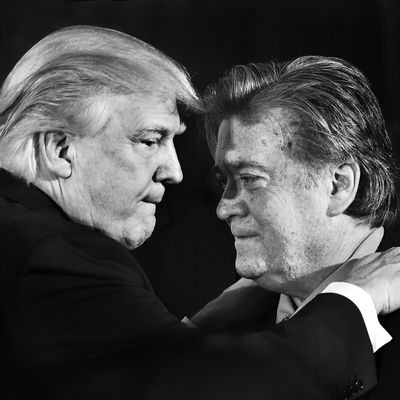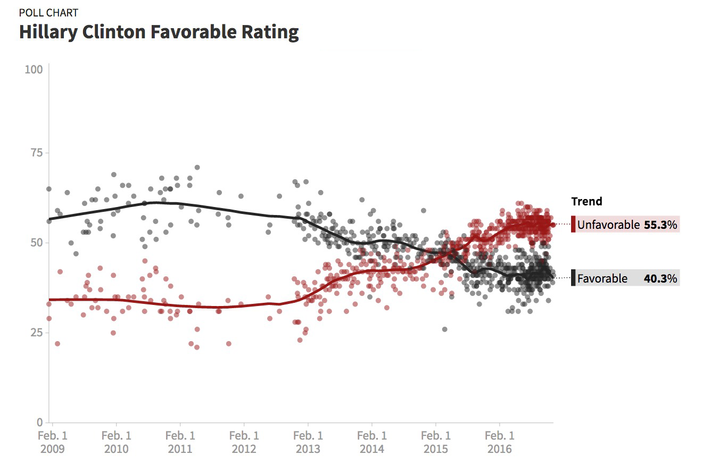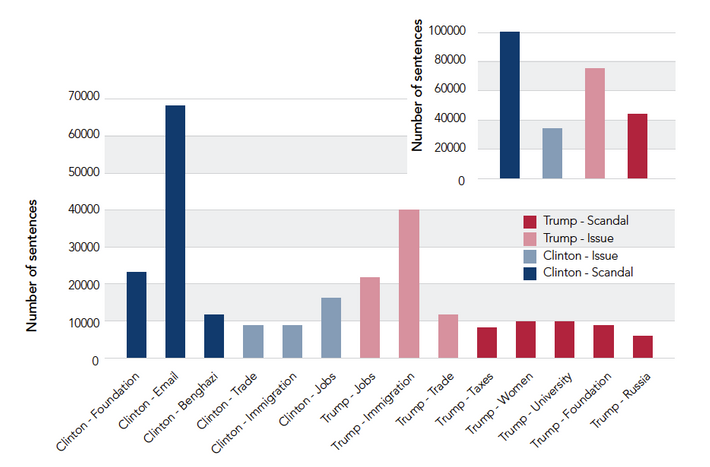
Steve Bannon, the most recent loser in the White House game of thrones, leaves the White House best known as the chief ideologist of a new right-wing synthesis, which he used to call “alt-right” and now calls “nationalism.” Those ideas, though, have been followed only intermittently. President Trump has followed Bannon’s xenophobia and barely disguised racism, but ignored his anti-Semitism and fascination with fomenting trade war with China, a trillion dollar infrastructure bill, and a higher tax rate on the rich. Bannon’s true contribution to Trump is less widely understood. “Devil’s Bargain,” Josh Green’s fine history of Bannon’s role in the campaign, makes clear that the chief strategist’s essential work lay in his attacks on Hillary Clinton. That was what won the presidency for Trump. And that, of course, is a skill made obsolete through Trump’s victory.
As Green explains, Bannon came out of a wing of the conservative movement that was professionally dedicated to discrediting Bill and Hillary Clinton. The anti-Clinton industry had existed since the early 1990s as both a partisan messaging tool and a reliable source of income. Bannon’s key insight was that the anti-Clinton campaign of the 1990s failed. The conservative media ecosystem recirculated lurid fantasies that the Clintons were murderers, connected to a drug cartel, and so on. They whipped their base into a failed crusade for impeachment while destroying their credibility with the mainstream media.
Rather than dismiss the mainstream media as hopelessly biased, as most conservatives did, Bannon grasped both its importance and potential utility. He believed sufficiently credible research could be injected into news organs that potential Clinton voters would read. He helped fund and direct research, such as “Clinton Cash,” which depicted Hillary Clinton as greedy and criminal.
Bannon’s work in the anti-Clinton complex turned out to shape the battlefield for the campaign in precisely the way he predicted. The news media relentlessly cast the Democratic front-runner as secretive and corrupt, to the point where she was almost no longer the front-runner at all. Her favorable ratings were bound to fall when she returned from a non-political role as secretary of State to candidate taking live bullets. But the scope of the fall was shocking:

The rousing success of Bernie Sanders was largely a product of Clinton’s corrupt reputation. Polling found there was no ideological difference between Clinton voters and Sanders voters. His support was based on disgust with the process.
Bannon did not join Trump’s campaign until the desperate final weeks, at which point his defeat was considered a fait accompli, and the task was understood as minimizing the broader damage to the party. But Bannon understood the power of anti-Clintonism as both a sword and a shield. The relentless attacks on the Democrat continuously shored up the Republican base, even in the face of devastating revelations like the audio tape of Trump boasting about his habit of sexual assault. And it served just as well to depress the Democratic base, much of which was never able to overcome the glum aura that had clung to its candidate.
News coverage defined Clinton largely — indeed, almost entirely — through the prism of scandal, with the Clinton Foundation and email stories comprising the overwhelming majority of news stories about her:

It was Bannon who advised Trump to turn every issue into an attack on his opponent. In the final weeks, Trump used a debate to turn his own sexual assaults into countercharges against Bill Clinton. And his closing message depicted the Democrat as a corrupt handmaiden of wealth, in Bannon’s trademark populist and barely concealed anti-Semitic attacks on Goldman Sachs and Wall Street:
The populism worked because conservatives, especially Bannon, had spent years laying the groundwork to dismiss Clinton as a puppet for the rich and powerful. Of course, he still would have lost if not for the interventions of FBI director James Comey and Russian intelligence (the latter of which may well prove to have been coordinated through Trump’s campaign). Bannon hoped to translate it into a positive governing program that would cement the Republican Party as a (white) working-class populist faction. But Trump never heeded the economic side of Bannon’s vision.
Wall Street, which Bannon had instructed his candidate to denounce, rallied on the news of his victory, believing (correctly) he would commit himself to a traditional Republican agenda of tax cuts and deregulation. Trump turned to Goldman Sachs to help staff his administration and frequently held up the rising stock market as an index of his own success. He tried as well to return to the Clinton-bashing theme, but drew predictably diminishing returns from attempting to contrast himself with his now-vanquished foe.
If Bannonism was the road map for a governing program, Bannon can fairly say it has never really been attempted. He mostly lost his internal power struggles, in part because the traditional Republican agenda had a worked-out (if not workable) plan of action, while he had little more than slogans and concepts.
And of course Bannon’s strengths and limitations are Trump’s as well. Trump won the nomination by outflanking every other Republican as an authoritarian demagogue and a racist. After winning the nomination, beating up on Hillary Clinton, and making her nearly as unpopular as Trump himself, has been the only thing either man accomplished.






























